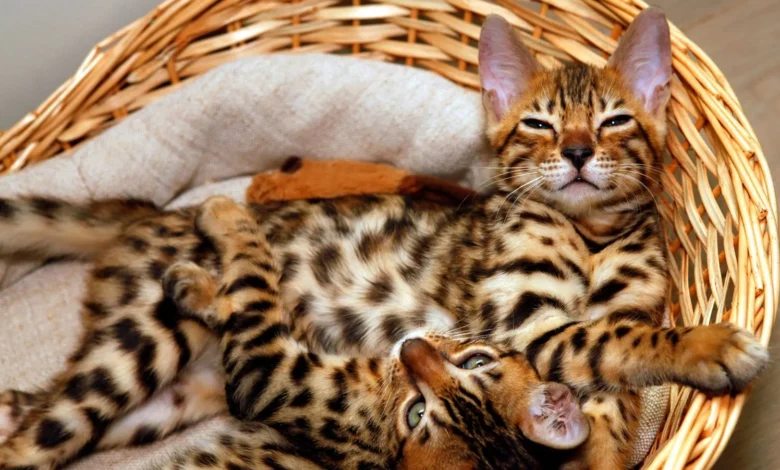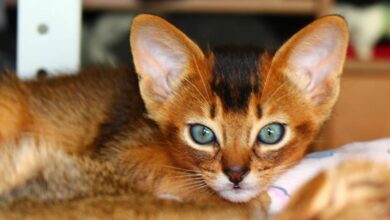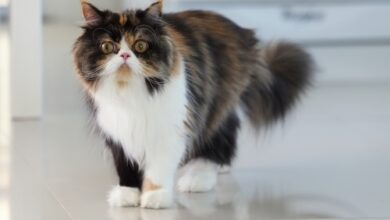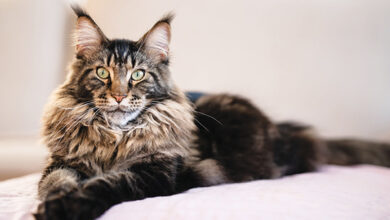An Introduction to These Gorgeous Hybrid Kitties: Bengal Cats

Frequently Asked Questions about Bengal Cats
Why are Bengal cats illegal?
In some countries and states, first-generation (F1) Bengal cats containing up to 50% wild leopard cat DNA are prohibited or require permits due to potential risks if they escape into the wild. However, later generations of domesticated Bengals pose no such threat and are legal as household pets. Always check local regulations before acquiring an F4 or higher Bengal.
Is a Bengal cat a good pet?
Yes, provided they get enough attention, playtime, and a stimulating environment that matches their high energy levels. Bengals bond closely with their owners but may be frightened easily if not properly socialized. They need experienced cat owners committed to meeting their needs through enrichment and positive discipline. With the right care, Bengals thrive as wonderful furry companions.
What do Bengal cats eat?
Like all cats, Bengals should consume high-quality protein-rich commercial cat food formulated for their age, activity level, and life stage. Some owners supplement canned or raw diets. Ensure ample fresh water is available at all times. Treats should be given sparingly to avoid obesity risk in this active breed. Consult your vet for dietary advice tailored to your individual Bengal cat.
What are Bengal cats used for?
Bengals are companion pets, not working animals. Unlike show cats, they were not specifically bred for conformation appearances in the ring but rather to preserve the exotic colors and spotted patterns inherited from their wild Asian Leopard Cat ancestry in a domestic companion breed. Their affectionate nature also makes them popular licensed therapy animals able to comfort people in hospitals or nursing homes when properly trained.
What are the Bengal cats immune to?
Just like domesticated housecats, Bengal cats can contract viruses, parasites, and other infections if not properly vaccinated or medicated to prevent disease. Good preventative healthcare, including flea/tick/worm treatments, vaccination boosters, and regular preventative wellness exams with your veterinarian, is key to keeping your Bengal cat healthy. No cat breed has any special immunity – responsible ownership means proactively protecting their health through preventative care.
Bengal cats are a strikingly beautiful hybrid breed known for their wild-rosetted coat patterns and energetic, playful personalities. Often compared to small exotic pets due to their distinctive leopard-like appearance and affectionate nature, Bengal cats make wonderful companions when properly socialized and cared for.
Bengal Cat Breeds
There are two main Bengal cat breeds recognized today – the F4 and F5 generations. Let’s take a closer look at each:
F4 Bengal Cats
Also called “first-generation” Bengals, F4 cats contain 75% domestic cat DNA and 25% Asian leopard cat DNA. They have the chunkiest build and tend to be the most dominant and territorial breed. Due to their wilder nature, F4 Bengals require an experienced cat owner who can provide them with plenty of mental and physical stimulation.
F5 (and Beyond) Bengal Cats
Further generations bred from domestic cats, such as F5 or F6 cats, have less wildcat DNA (12.5% or lower). They have leaner builds and tend to be slightly calmer with more domesticated traits. F5 and later Bengal cats still retain their allure but make excellent family pets thanks to their friendly, outgoing personalities.
Bengal Cat Lifespan
On average, Bengal cats have a lifespan of 12-15 years when provided with excellent medical care, nutritious food and a loving home. Some may live up to 18-20 years, while others may pass younger due to genetic health issues or accidents. Ensure you choose a Bengal cat breeder who screens for hereditary illnesses and takes care to breed only healthy specimens. Proactive preventative healthcare from your vet can help your Bengal cat achieve a long, happy life.
Bengal Cat Personality
Bengal cats are highly intelligent, playful, and acrobatic. Young kittens especially enjoy romping, climbing, pouncing on toys, and investigating new scents and sounds. As they mature, they retain their youthful liveliness but also grow affectionate towards their human families. Daily interactive playtime and enrichment through toys, scratching posts, and climbing structures are important to satisfy their naturally energetic dispositions. Gentle, positive training also helps channel their wild spirit into acceptable behaviors inside the home. Most Bengal cats bond strongly with one or two special people but can be shy around strangers at first. With early socialization, they become friendly and playful cats who love attention on their terms.
Bengal Cat Size
On average, adult male Bengal cats weigh between 12-18 pounds, while females are generally 8-15 pounds. Their compact, muscular bodies allow them to leap great heights and distances. Well-bred specimens adhere closely to standard Bengal cat sizes appropriate for their gender. Overly large or small kittens could indicate out-crosses or health issues, so responsibly buy from reputable programs following strict breed standards. Thanks to their exotic multi-generational genetics, no two Bengals look exactly alike – but all possess stunning rosette coats, and athletic builds befitting their wild ancestry.
Bengal Cat Price
The purchase price for quality purebred Bengal cats varies depending on location, bloodline, breeder reputation, and generation. On average, expect to pay:
- F4 kittens: $2500-4000 USD each
- F5 kittens: $1000-2500 USD each
- F5/F6 retired breeding cats: $600-1500 USD
- “Companion” cats sold without breeding rights: $800-2000 USD
Higher costs typically reflect desirable coat patterns (Marble, Mosaic etc), champion pedigree, extensive health testing and excellent temperament. Always get written guarantees, vet references and meet both parents when possible. New breeders just starting out may offer lower prices to establish a reputation – but avoid “bargains” without proven backgrounds. The investment ensures a healthy, well-socialized lifelong furry friend.
Bengal Cat White
All Bengal coat patterns stem from the wild Asian leopard cat genes, giving each unique, beautiful markings. Main patterns seen include:
- Brown/Black-Marbled: Brown or black rosettes on a lighter tan/beige background
- Snow/Silver: Dilute brown/black rosettes appear lighter gray on pale coat
- Mosaic: Distinct lighter and darker circular patches form complex patterns
- Rosette: Distinct individual light and dark colored circular patches resembling a leopard’s spots
- Ticked Tabby: Light and dark bands see through fur resembling a woodland cat
- White Bengals can also occur, though less frequently seen. Any coat pattern may appear on a white cat.
Difference between a Bengal Cat and a Normal Domestic Cat
While both can make wonderful pets, Bengals differ from typical housecats in several key ways:
- Appearance: Bengals have a muscular, athletic build and stunning exotic rosette coat patterns not seen in moggies.
- Personality: They tend to be more energetic, playful, and vocal and enjoy climbing more than regular domesticated breeds. Early socialization is important.
- Size: On average larger than housecats, though size can vary in individual Bengals.
- Lifespan: Similar to domesticated cats, but requires ongoing medical care to avoid early onset of hereditary conditions.
- Price: Purebred Bengals come at a premium cost versus moggie adoptions from shelters. Multigenerational lineage adds to the value.
- Care: Benefit from an appropriately challenging environment, including climbing space, interactive playtime, and positive reinforcement training.
With their devoted affectionate natures and stunning exotic beauty, Bengals make truly unique and special feline companions when paired with a suitably experienced owner ready for their higher-energy lifestyle needs compared to typical pet cats.
In conclusion, Bengal cats make truly stunning companion animals with their unique wild-like coats and devoted, trainable personalities. While not suitable first pets due to their high-energy needs, Bengals thrive as loyal family members when reared in caring homes meeting their mental, physical, and socialization requirements. With the proper investment in multigenerational health screening, quality nutrition, preventative healthcare, and above all else – daily interaction and engaged ownership – Bengal cats reward their humans with many joyful years together as treasured furry friends like no other breed.



